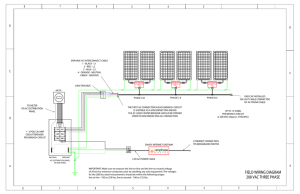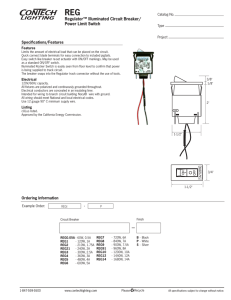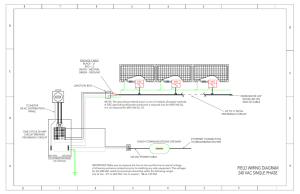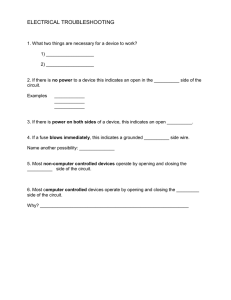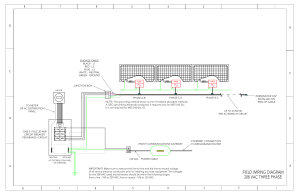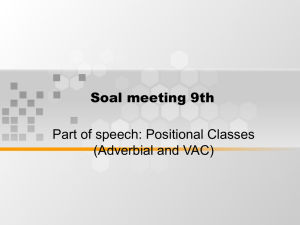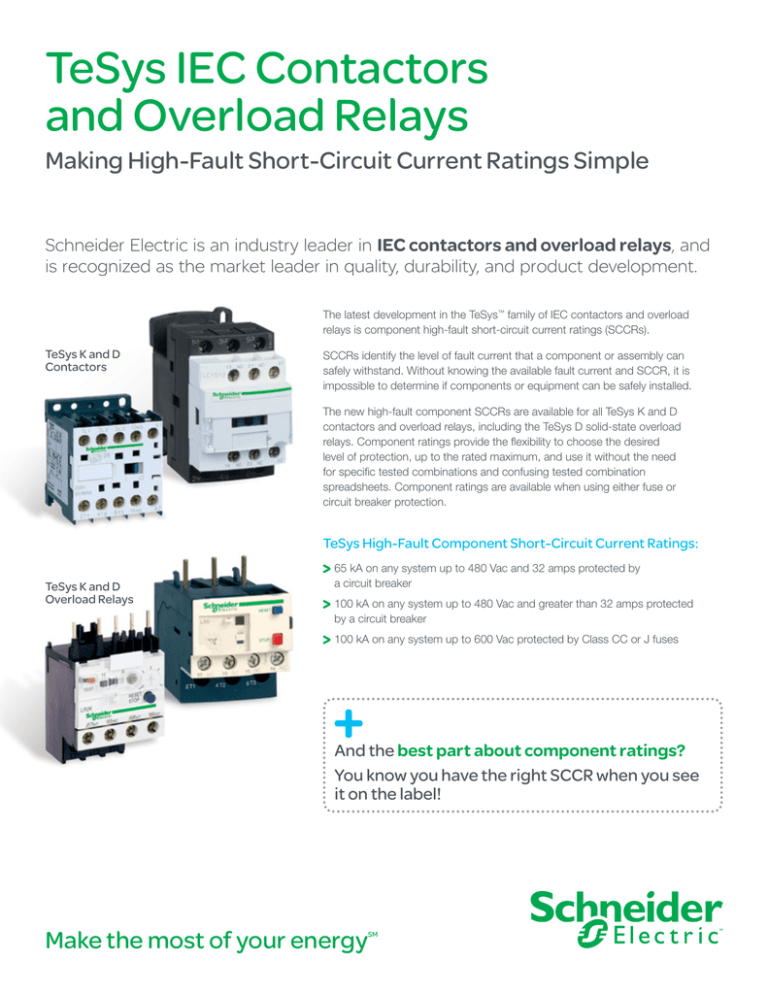
TeSys IEC Contactors
and Overload Relays
Making High-Fault Short-Circuit Current Ratings Simple
Schneider Electric is an industry leader in IEC contactors and overload relays, and
is recognized as the market leader in quality, durability, and product development.
The latest development in the TeSys™ family of IEC contactors and overload
relays is component high-fault short-circuit current ratings (SCCRs).
TeSys K and D
Contactors
SCCRs identify the level of fault current that a component or assembly can
safely withstand. Without knowing the available fault current and SCCR, it is
impossible to determine if components or equipment can be safely installed.
The new high-fault component SCCRs are available for all TeSys K and D
contactors and overload relays, including the TeSys D solid-state overload
relays. Component ratings provide the flexibility to choose the desired
level of protection, up to the rated maximum, and use it without the need
for specific tested combinations and confusing tested combination
spreadsheets. Component ratings are available when using either fuse or
circuit breaker protection.
TeSys High-Fault Component Short-Circuit Current Ratings:
TeSys K and D
Overload Relays
65 kA on any system up to 480 Vac and 32 amps protected by
a circuit breaker
100 kA on any system up to 480 Vac and greater than 32 amps protected
by a circuit breaker
100 kA on any system up to 600 Vac protected by Class CC or J fuses
And the best part about component ratings?
You know you have the right SCCR when you see
it on the label!
Make the most of your energy
SM
TeSys K and D Contactors and Overload Relays
TeSys K Contactors
Maximum Horsepower Ratings
Catalog Number
LC1K06
LC1K09
LC1K12
Single-Phase
Maximum Component SCCR (kA)[1]
Three-Phase
120 Vac
240 Vac
240 Vac
480 Vac
600 Vac
Circuit Breakers
@ 480 Vac[2]
Fuses
@ 600 Vac[3]
0.5
0.5
0.5
1.5
1.5
1.5
1.5
3
3
3
5
7.5
3
5
10
65
65
65
100
100
100
TeSys D Contactors
Maximum Horsepower Ratings
Catalog Number
LC1D09
LC1D12
LC1D18
LC1D25
LC1D32
LC1D40A
LC1D50A
LC1D65A
LC1D80
LC1D115
LC1D150
Single-Phase
Maximum Component SCCR (kA)[1]
Three-Phase
120 Vac
240 Vac
240 Vac
480 Vac
600 Vac
Circuit Breakers
@ 480 Vac[2]
Fuses
@ 600 Vac[3]
0.5
1
1
2
2
3
3
5
7.5
—
—
1
2
3
3
5
5
7.5
10
15
—
—
2
3
5
7.5
10
10
15
20
30
40
50
5
7.5
10
15
20
30
40
40
60
75
100
7.5
10
15
20
30
30
40
50
60
100
125
85
85
85
85
85
100
100
100
100
100
100
100
100
100
100
100
100
100
100
100
100
100
TeSys K Overload Relays
Current Setting Range (A)
0.1 – 0.16
0.16 – 0.23
0.23 – 0.36
0.36 – 0.54
0.54 – 0.8
0.8 – 1.2
1.2 – 1.8
1.8 – 2.6
2.6 – 3.7
3.8 – 5.5
5.5 – 8
8 – 11.5
Maximum Component SCCR[1]
Class 10 with
Single-Phase Sensitivity
Circuit Breakers @ 480 V[2]
Fuses @ 600 V[3]
Max. SCCR (kA)
Max. SCCR (kA)
LR2K0301
LR2K0302
LR2K0303
LR2K0304
LR2K0305
LR2K0306
LR2K0307
LR2K0308
LR2K0310
LR2K0312
LR2K0314
LR2K0316
65
65
65
65
65
65
65
65
65
65
65
65
100
100
100
100
100
100
100
100
100
100
100
100
Ratings apply to circuits with voltage no greater than those listed and are subject to maximum breaker and fuse ampacities. See data
bulletin 8536DB0901 for ampacity limitations.
[2]
When protected by any circuit breaker, including thermal-magnetic and magnetic-only.
[3]
When protected by any Class J or CC time-delay fuse (Class CC applicable up to 30 amps only).
[1]
Note: These tables list the maximum SCCR of the component when protected by any circuit breaker or fuse. If the maximum component
SCCR is 65 kA and a 25 kA rated circuit breaker is used, then the system will be 25 kA as the circuit breaker becomes the weakest link.
2
TeSys D Overload Relays
Class 10
Class 10 with
Class 20 with
without
Single-Phase
Single-Phase
Single-Phase
Sensitivity
Sensitivity
Sensitivity
Maximum Component SCCR (kA)[1]
Class 20
without
Circuit Breakers Fuses
Single-Phase @ 480 V[2]
@ 600 V[3]
Sensitivity
Max. SCCR (kA) Max. SCCR (kA)
0.10 – 0.16
LRD01
LR3D01
—
—
65
100
0.16 – 0.25
LRD02
LR3D02
—
—
65
100
0.25 – 0.40
LRD03
LR3D03
—
—
65
100
0.40 – 0.63
LRD04
LR3D04
—
—
65
100
0.63 – 1
LRD05
LR3D05
—
—
65
100
Current
Setting
Range (A)
1 – 1.6
For Direct
Mounting to
LC1…
LRD06
LR3D06
—
—
65
100
1.6 – 2.5
D09 – D32
LRD07
LR3D07
—
—
65
100
2.5 – 4
LRD08
LR3D08
LRD1508
LR3D1508A
65
100
4–6
LRD10
LR3D10
LRD1510
LR3D1510A
65
100
5.5 – 8
LRD12
LR3D12
LRD1512
LR3D1512A
65
100
7 – 10
LRD14
LR3D14
LRD1514
LR3D1514A
65
100
9 – 13
D12 – D32
LRD16
LR3D16
LRD1516
LR3D1516A
65
100
12 – 18
D18 – D32
LRD21
LR3D21
LRD1521
LR3D1521A
65
100
16 – 24
LRD22
LR3D22
—
—
65
100
17 – 25
—
—
LRD1522
LR3D1522A
65
100
LRD32
LR3D32
—
—
65
100
—
—
LRD1530
LR3D1530A
65
100
—
—
LRD1532
LR3D1532A
65
100
LRD35
LR3D35
—
—
65
100
9 – 13
LRD313
LR3D313
LRD313L
—
100
100
12 – 18
LRD318
LR3D318
LRD318L
—
100
100
16 – 25
LRD325
LR3D325
LRD325L
—
100
100
LRD332
LR3D332
LRD332L
—
100
100
LRD340
LR3D340
LRD340L
—
100
100
37 – 50
LRD350
LR3D350
LRD350L
—
100
100
48 – 65
D50A – D65A[4] LRD365
LR3D365
LRD365L
—
100
100
LRD3322
LR3D3322
LR2D3522
LR3D3522
100
100
LRD3353
LR3D3353
LR2D3553
LR3D3553
100
100
LRD3355
LR3D3355
LR2D3555
LR3D3555
100
100
LRD3357
LR3D3357
LR2D3557
LR3D3557
100
100
LRD3359
LR3D3359
LR2D3559
LR3D3559
100
100
LRD3361
LR3D3361
LR2D3561
LR3D3561
100
100
LRD3363
LR3D3363
LR2D3563
LR3D3563
100
100
LRD3365
—
—
—
100
100
LRD4365
—
—
—
100
100
LRD4367
—
—
—
100
100
23 – 32
D25 – D32
23 – 28
25 – 32
30 – 38
23 – 32
D32
D40A – D65A[4]
30 – 40
17 – 25
23 – 32
D40 – D80[5]
30 – 40
37 – 50
48 – 65
55 – 70
63 – 80
80 – 104
80 – 104
95 – 120
D50 – D80[5]
D65 – D80[5]
D80
D115 – D150
Ratings apply to circuits with voltages no greater than those listed and are subject to maximum breaker and fuse ampacities. See data
bulletin 8536DB0901 for ampacity limitations.
[2]
When protected by any circuit breaker, including thermal-magnetic and magnetic-only.
[3]
When protected by any Class J or CC time-delay fuse (Class CC applicable up to 30 A only).
[4]
Overload relays with Everlink™ termination — direct mount to D40A to D65A only.
[5]
Direct mount to old D2 style D40 to D65 (no Everlink terminations) and to D80 only.
[1]
Note: This table lists the maximum SCCR of the component when protected by any circuit breaker or fuse. If the maximum component SCCR
is 100 kA and a 25 kA rated circuit breaker is used, then the system will be 25 kA as the circuit breaker becomes the weakest link.
3
TeSys K and D Contactors and Overload Relays
TeSys D Overload Relays — Solid State
Class 20
Maximum Component SCCR[1]
Class
Circuit Breakers
10 or 20
Fuses @ 600 V[3]
@ 480 V[2]
Selectable
Max. SCCR (kA) Max. SCCR (kA)
D115 – D150 LR9D5367
LR9D5567
LR9D67
100
100
D115 – D150 LR9D5369
LR9D5569
LR9D69
100
100
Current
Setting
Range (A)
For Direct
Mounting to
LC1…
60 – 100
90 – 150
Class 10
Ratings apply to circuits with voltages no greater than those listed and are subject to maximum breaker and fuse ampacities. See data
bulletin 8536DB0901 for ampacity limitations.
[2]
When protected by any circuit breaker, including thermal-magnetic and magnetic-only.
[3]
When protected by any Class J time-delay fuse.
[1]
©2012 Schneider Electric. All Rights Reserved. All trademarks are owned by Schneider Electric Industries SAS or its affiliated companies. 998-1176922_US
Note: This table lists the maximum SCCR of the component when protected by any circuit breaker or fuse. If the maximum component SCCR
is 100 kA and a 25 kA rated circuit breaker is used, then the system will be 25 kA as the circuit breaker becomes the weakest link.
For more information on high-fault component short-circuit current ratings
including maximum fuse and breaker ampacities, please refer to the TeSys Motor
Control Solutions for the North American Market data bulletin (8536DB0901).
Schneider Electric USA
1415 S. Roselle Road
Palatine, IL 60067
Tel: 847-397-2600
Fax: 847-925-7500
www.schneider-electric.com/us
Document Number 8502HO1201
October 2012

